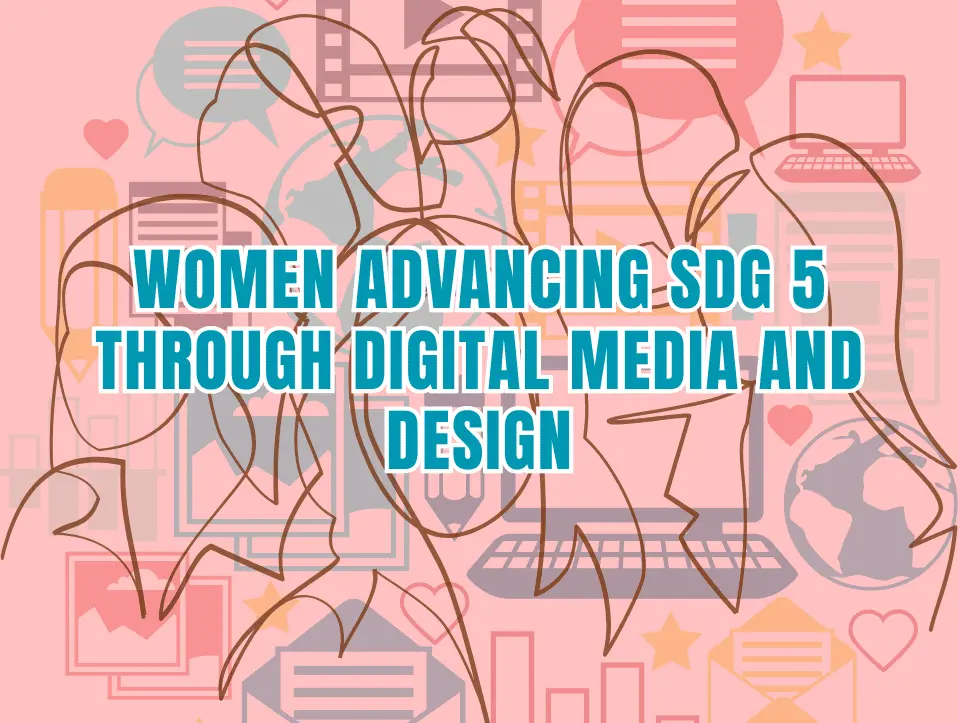Advancing SDG 5 Through Women in Digital Media and Design
Gender equality is at the heart of the Sustainable Development Goals, and SDG 5 focuses on achieving equality for women and girls across all areas of life. In the modern world, digital media and design have become powerful platforms where voices are amplified, ideas are shared, and influence is shaped.
For women, these platforms open new doors of opportunity. They allow women not only to share their perspectives but also to lead conversations that impact society and inspire change. The rise of social media platforms, digital storytelling, and creative design industries has changed the way the world consumes information.
Women who were once left behind in traditional spaces now have direct access to audiences without waiting for permission from gatekeepers. Whether through graphic design, filmmaking, animation, or social media content creation, women are claiming their space. They are showing that digital platforms can be used to challenge stereotypes, push for social justice, and highlight issues often ignored by mainstream voices.
SDG 5 emphasizes that women should have equal participation in decision-making, leadership, and access to technology. Digital media and design industries provide a pathway to achieve this vision. A young woman in a rural area with just a smartphone and internet connection can tell her story, start a business, or build a following that influences thousands. These opportunities are more than just individual success stories.
They are steps toward collective empowerment, where women’s voices shape the cultural and economic landscape of society. At the same time, these platforms come with responsibility. Promoting gender equality in digital spaces is not only about representation. It is also about ensuring women have safe environments, equal pay, professional growth, and recognition for their contributions.
As more women enter these fields, there is a need to provide them with mentorship, financial support, and technical skills that strengthen their journey. In this blog, we will explore how women are shaping the future of digital media and design, the challenges they continue to face, the opportunities for innovation, and how these efforts connect with the global movement for SDG 5. By understanding the power of women’s voices in the digital world, we can see how real progress toward gender equality is being made.
The Evolving Role of Women in Digital Media and Creative Industries
The role of women in digital media and design has changed dramatically over the past two decades. Once limited to supportive or background roles, women are now at the center of creative leadership. They are directing films, leading design agencies, building global fashion brands, running digital startups, and shaping content that travels across borders. Their presence has brought fresh perspectives, storytelling styles, and innovations that enrich the industry.
Digital media has reduced many of the barriers that used to keep women out of traditional media. In the past, launching a career in journalism, film, or design often required financial backing, strong networks, and access to limited opportunities. Today, women can build their portfolios online, share their work on platforms like Behance or Instagram, and reach international clients without needing traditional gatekeepers. This shift has democratized the creative world, and women are taking full advantage of it.
Women in design bring diversity not just in numbers but in ideas. They design with sensitivity, inclusivity, and awareness of social issues. For example, female designers have been behind campaigns that highlight issues like gender-based violence, body positivity, and climate change. Their work goes beyond aesthetics; it shapes conversations that matter. In advertising and branding, women are changing the way products and lifestyles are represented.
Instead of reinforcing stereotypes, they are challenging them with new narratives. In film and digital storytelling, women directors, writers, and producers are telling stories that were once silenced. Their representation of women’s lives is more realistic, nuanced, and powerful. Digital media also gives them freedom to explore genres that were once male-dominated, such as science fiction, technology-driven films, and political documentaries.
The rise of women in creative industries is not limited to large cities or developed nations. Across developing countries, women are entering these fields as freelancers, entrepreneurs, and innovators. They are running YouTube channels, podcast series, online art exhibitions, and design studios. The availability of affordable technology has allowed them to showcase their talent, earn independently, and contribute to their communities. This evolving role shows that women are not just participants in digital media and design; they are leaders shaping its future. They are using their creativity to make industries more inclusive and to open paths for the next generation of young women. This transformation connects directly with SDG 5 by ensuring equal opportunities for women in leadership, innovation, and economic participation.
Challenges and Barriers to Gender Equality in the Digital Era
Despite the progress, women still face significant barriers in digital media and design. The promise of equal access and opportunity is not yet fully realized. Many women continue to struggle against systemic issues such as unequal pay, limited career growth, workplace harassment, and underrepresentation in leadership roles. One of the biggest challenges is the gender pay gap. Even in creative industries, women are often paid less than men for the same work. Freelancers report that clients tend to undervalue work done by women, assuming it requires less skill or time. In large organizations, fewer women are found in senior design positions, which results in limited representation in decision-making. Workplace safety is another issue. Online harassment has become a growing concern, particularly for women who are active on digital platforms. Content creators, journalists, and designers often face cyberbullying, hate speech, and threats. This not only affects their mental health but also discourages many from fully participating in digital spaces.
Access to technology is also unequal. While women in urban areas may have access to the latest tools, many women in rural regions face barriers such as poor internet connectivity, lack of devices, and limited training opportunities. Without addressing this digital divide, achieving SDG 5 will remain a challenge. Cultural stereotypes further complicate the situation. In some societies, women pursuing careers in digital media are not taken seriously, and their work is often dismissed as a hobby rather than a profession. Family pressures and societal expectations also restrict their ability to invest time and energy in their careers. Another challenge is visibility. Even when women produce exceptional work, they often receive less recognition compared to men. Media coverage, industry awards, and funding opportunities are still heavily male-dominated. This lack of visibility keeps women from gaining the networks and platforms needed to grow their influence.
To move forward, these barriers must be addressed with policy changes, corporate responsibility, and societal awareness. Governments need to ensure equal pay laws are enforced. Companies must create inclusive work cultures that promote women into leadership roles. Educational institutions should integrate digital and design skills into programs targeted at women and girls. Civil society and advocacy groups must continue to push for safer online environments. The challenges are real, but they are not impossible to overcome. Every barrier broken by one woman paves the way for many others to follow. Addressing these issues directly will ensure that digital media and design become truly inclusive spaces that advance gender equality as envisioned in SDG 5.
Empowering Women’s Voices: Opportunities, Innovations, and Global Initiatives
While challenges remain, the digital era is also filled with opportunities for women to grow, innovate, and lead. The creative industries are constantly evolving, and women are finding new ways to make their mark. From entrepreneurship to activism, digital media and design are providing platforms where women’s voices are not just heard but celebrated. One of the most powerful opportunities is entrepreneurship. Women are building startups in digital design, content creation, and creative services. Online freelancing platforms allow them to reach clients across the globe, breaking free from local limitations. This independence gives women financial stability and the ability to invest in their growth.
Innovation is another area where women are thriving. Digital tools like artificial intelligence, virtual reality, and animation are being used by women to create new forms of storytelling and design. For example, female-led design firms are exploring how virtual reality can be used in education, while women filmmakers are using low-cost technology to produce films that reach global audiences. Global initiatives are also playing an important role. Programs led by the United Nations, NGOs, and governments are providing training, mentorship, and funding for women in digital industries.
Initiatives like Girls in Tech, Women in Design, and UN Women’s innovation projects are giving women the confidence and resources to step into fields that were once closed to them. Social media campaigns have also created opportunities for women’s empowerment. Movements like #MeToo and #WomenInDesign have shown how digital platforms can unite women across borders to share experiences, demand justice, and push for equality. These campaigns prove that when women’s voices are amplified, society listens and responds.
Education is a key factor in empowering women’s participation. Online learning platforms are offering affordable courses in graphic design, coding, animation, and digital marketing. This gives women the skills they need to compete in the global market. Many women who could not attend formal universities are now using these courses to build careers from home. Collaboration across borders is another exciting opportunity. Women from different countries are working together on creative projects, sharing cultural perspectives, and building global networks. This cross-cultural exchange enriches design and storytelling while building solidarity for gender equality.These opportunities and initiatives highlight that the digital world is not only a space for challenges but also a platform for transformation. When women are given equal access, they create innovations that benefit everyone. This progress takes us closer to achieving SDG 5, where gender equality is no longer an aspiration but a reality.
Conclusion: Building a Gender-Inclusive Future in Media and Design
The journey toward gender equality in digital media and design is ongoing, but the progress made so far is inspiring. Women have moved from the margins to the center of creative industries. They are shaping stories, designing brands, leading campaigns, and driving conversations that influence society. Their voices are not only empowering themselves but also inspiring entire communities. Achieving SDG 5 requires more than just opportunities. It requires systems that are fair, safe, and inclusive. Women must be given equal pay, equal recognition, and equal access to technology. Digital platforms should ensure safe spaces where women can create without fear of harassment. Governments, companies, and communities all have a role to play in building environments that support women’s growth.
The power of digital media and design lies in its ability to reach people everywhere. A campaign designed in one part of the world can inspire action on the other side of the globe. When women are leading these efforts, the stories told are more inclusive, diverse, and authentic. They reflect the realities of women’s lives and highlight solutions that can bring lasting change. The future of digital media and design will be shaped by those who dare to innovate and tell new stories. Women are already proving they are ready for this role. With support, training, and opportunities, their impact will grow even stronger.In building a gender-inclusive future, we must remember that empowering women is not just about fairness. It is about unlocking the full potential of society. When women thrive, communities thrive. When their voices are heard, progress is made.
Digital media and design are powerful tools, and when guided by women’s creativity and leadership, they will play a central role in achieving the vision of SDG 5. A true transformation will happen when women’s contributions in digital spaces are celebrated as essential, not exceptional. Every design, story, or innovation led by women adds richness to the global narrative and challenges outdated systems. By nurturing these voices and giving them equal platforms, the world moves closer to a future where gender equality is not just a goal on paper but a lived reality across societies.


No responses yet